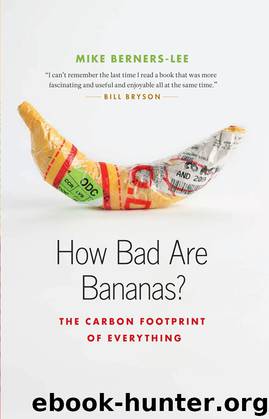How Bad Are Bananas?: The Carbon Footprint of Everything by Mike Berners-Lee

Author:Mike Berners-Lee [Berners-Lee, Mike]
Language: eng
Format: epub
Tags: Science, Environmental Science, Technology & Engineering, House & Home, Sustainable Living, SCI026000, Environmental, Global Warming & Climate Change, Pollution Control
ISBN: 9781553658320
Publisher: Greystone Books
Published: 2011-03-15T06:20:40+00:00
The machine itself
Even before you turn it on, a new iMac has the same footprint as flying from Glasgow to Madrid and back.
Apple has carried out a detailed life-cycle carbon assessment of their business and their products.11 This analysis suggests that the company’s mid-sized desktop machine— the 21.5-inch iMac—comes in at around 570 kg (1,250 lbs.) CO2e.12 However, the devil is in the details, and the life-cycle approach that Apple has used has a nasty habit of “leaking”—missing little bits of the footprint. The footprint of a computer comes from the complex mass of activity that has had to go on throughout the economy in order for minerals in the ground to turn into machines in the stores. Each component is in turn made of materials and other components, behind each of which lies a whole life cycle of its own. To trace this by mapping out the different processes one by one is impossible because the ripple effect is mathematically endless. You have to miss some processes out, cutting the pathways short, and the result is a shortfall in your footprint calculations that is known as “truncation error.” And it’s the reason that I think Apple’s figure is almost certain to be a little on the light side.
The “input–output” approach of tracing carbon impacts through the economy by modeling the way in which industries buy and sell from each other has, for all its generalizations, the huge advantage of not systematically missing bits out. Based on a 21.5-inch iMac costing $1,800 in the store, input–output modeling gives me a footprint estimate of about 720 kg (1,590 lbs.) CO2e. Just as expected, that is a bit higher than the figure produced by Apple’s process-based approach, so it is the one I have gone with.13
Apple, on its website, talks about reducing its impact by making machines lighter, but the bulk raw materials are just a small part of the issue. If a laptop were just a lump of plastic, steel, and semiconductor, you could get its footprint to below 50 kg (110 lbs.) CO2e. The problem is that microprocessors come in at around 5 kg (11 lbs.) CO2e for a 2 g chip because of the high-tech process that is involved and the incredibly clean environment that is needed.14 Apple also talks about reducing packaging; this, too, is good practice but makes a marginal difference in the scheme of things.
It’s hard to give guidance on what makes a low-carbon computer because the processes involved in making one are so complex. The guidance we would get from input–output analysis is that the cheaper your machine, the less its footprint is likely to be. This is probably a reasonable rule of thumb, although it may mask the impact of some cheap, carbon-intensive production in developing countries. Another guiding principle could be to choose the products from a country that has efficient industry and not too much reliance on coal for electricity—but this is tricky because assembly might take place in a country other than the one in which the most energy-intensive 2 gram components are made.
Download
This site does not store any files on its server. We only index and link to content provided by other sites. Please contact the content providers to delete copyright contents if any and email us, we'll remove relevant links or contents immediately.
Man-made Catastrophes and Risk Information Concealment by Dmitry Chernov & Didier Sornette(5921)
The Revenge of Geography: What the Map Tells Us About Coming Conflicts and the Battle Against Fate by Kaplan Robert D(4034)
Zero Waste Home by Bea Johnson(3777)
COSMOS by Carl Sagan(3553)
Good by S. Walden(3485)
In a Sunburned Country by Bill Bryson(3481)
The Fate of Rome: Climate, Disease, and the End of an Empire (The Princeton History of the Ancient World) by Kyle Harper(3003)
A Wilder Time by William E. Glassley(2818)
Camino Island by John Grisham(2762)
The Ogre by Doug Scott(2631)
Organic Mushroom Farming and Mycoremediation by Tradd Cotter(2626)
Human Dynamics Research in Smart and Connected Communities by Shih-Lung Shaw & Daniel Sui(2465)
Energy Myths and Realities by Vaclav Smil(2437)
The Traveler's Gift by Andy Andrews(2409)
9781803241661-PYTHON FOR ARCGIS PRO by Unknown(2321)
Inside the Middle East by Avi Melamed(2305)
Birds of New Guinea by Pratt Thane K.; Beehler Bruce M.; Anderton John C(2223)
A History of Warfare by John Keegan(2183)
Ultimate Navigation Manual by Lyle Brotherton(2129)
